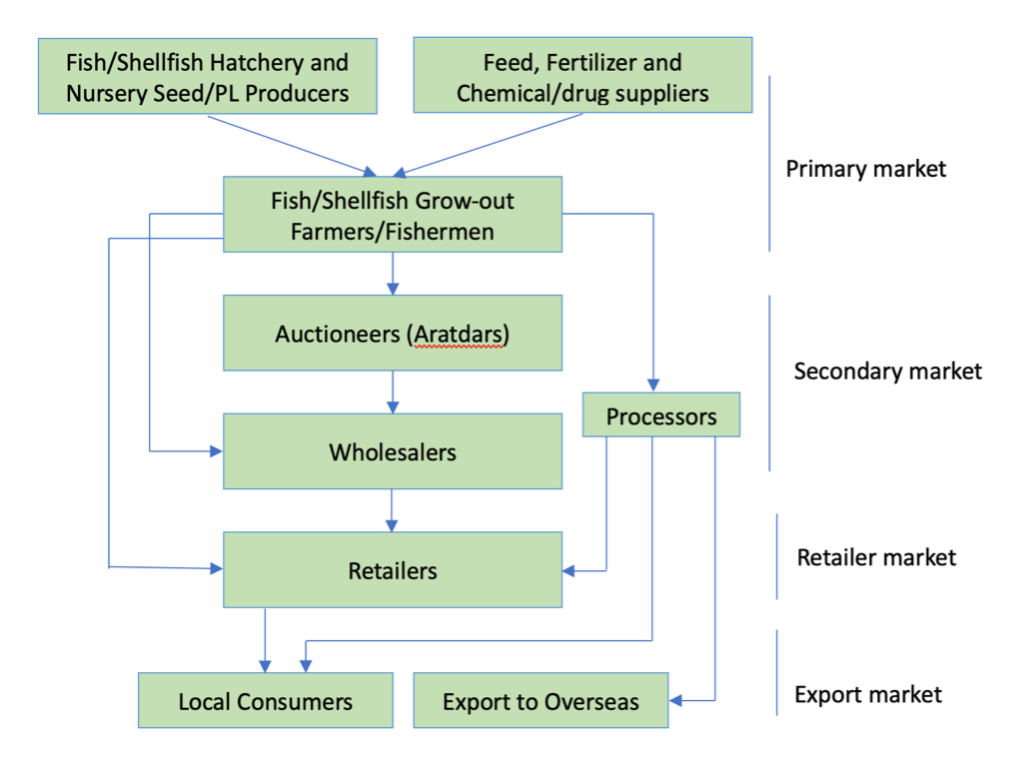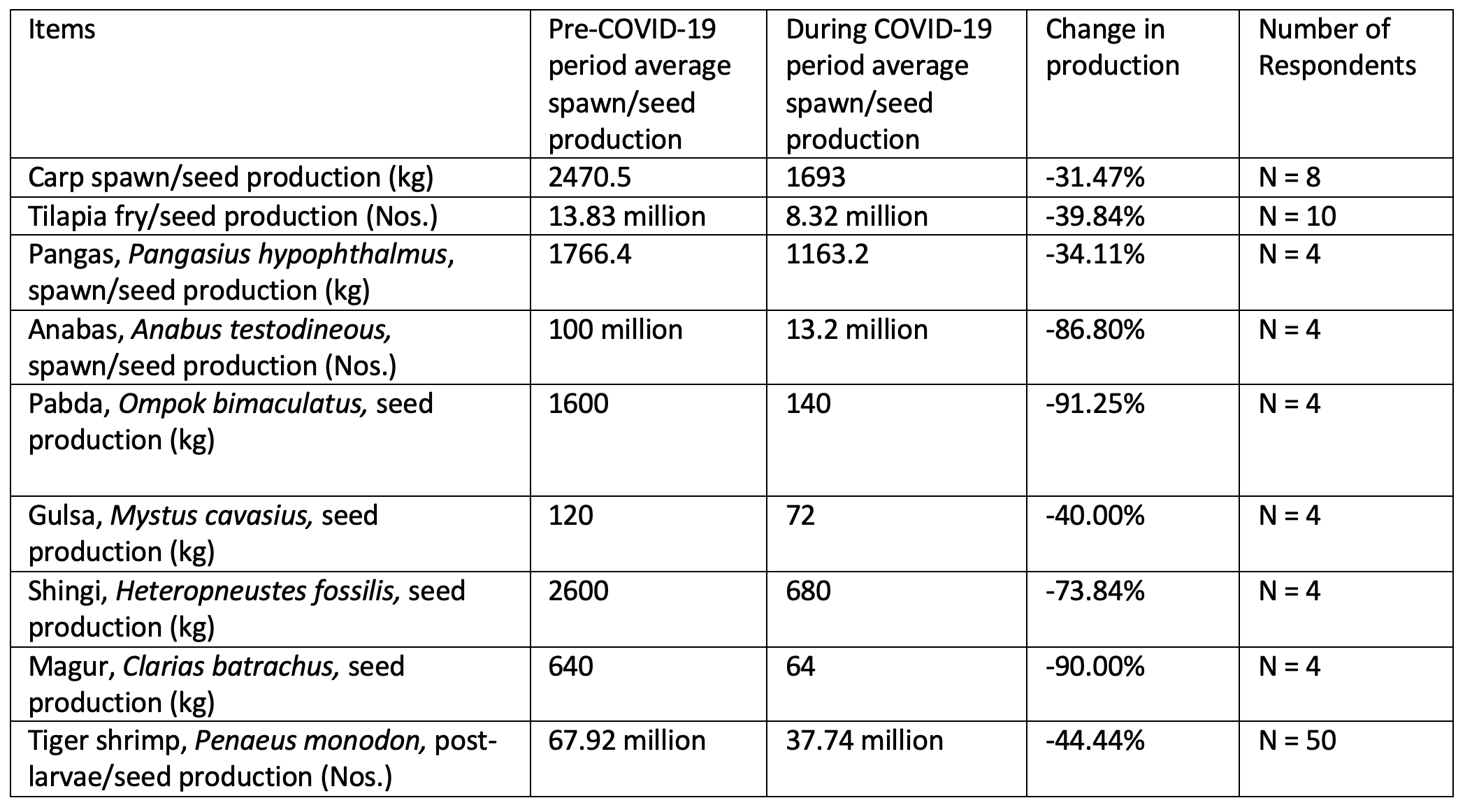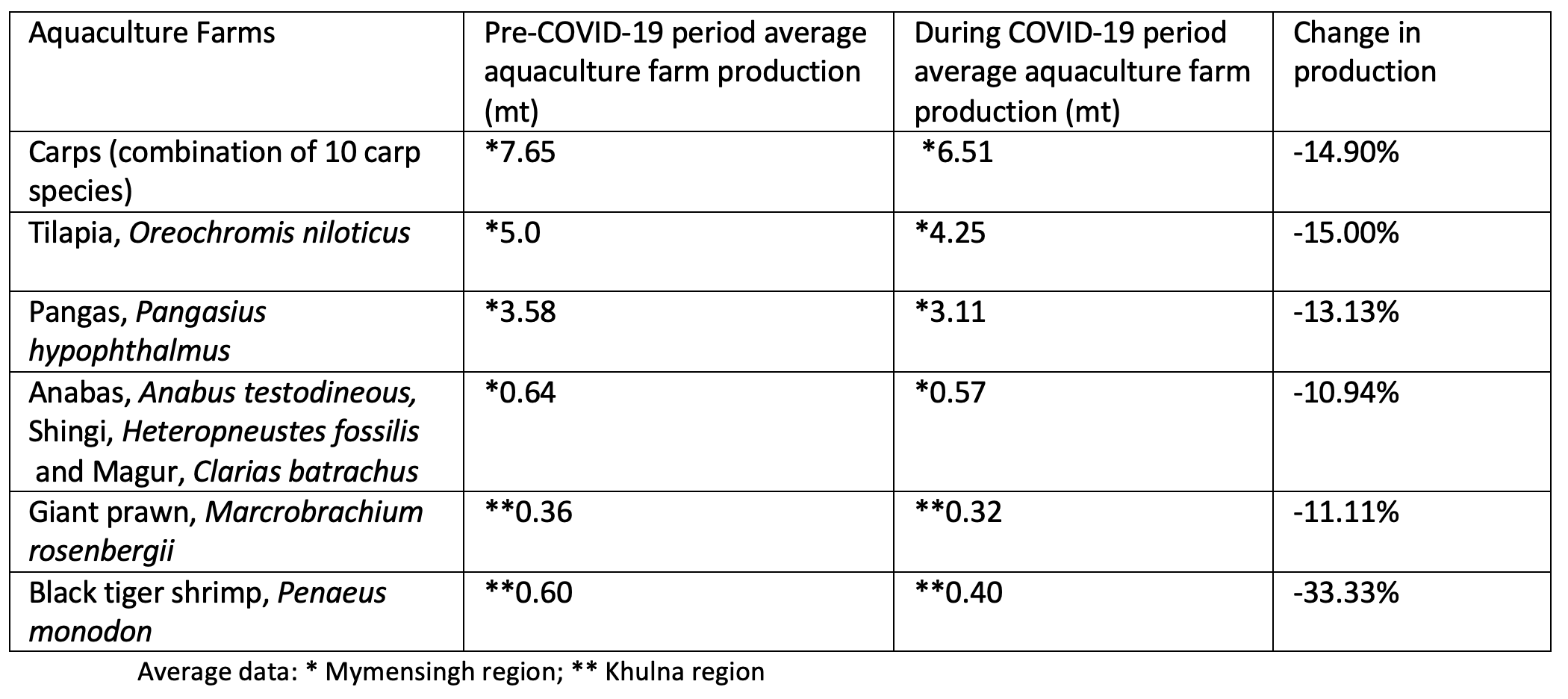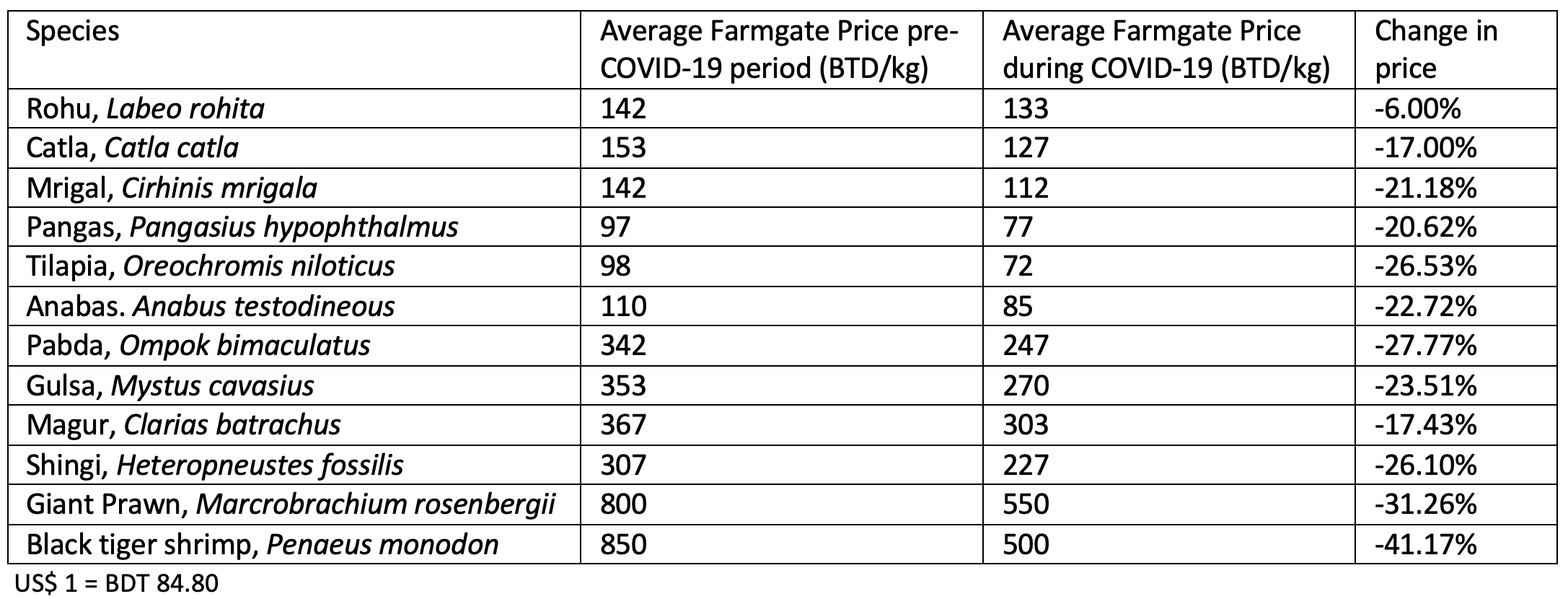M. Gulam Hussain
Overall editing and formatting by Kristen Dechert
Photos by M. Gulam Hussain
Restrictions on movement and access to businesses due to the COVID-19 pandemic have made significant disruptions in supply chains in Bangladesh, which has resulted in unprecedented economic losses. Aquaculture and fisheries are prominent sectors in the country, so disruptions in these supply chains affected both access to nutritious food and livelihoods, especially for small producers and sellers. A visual of the fish supply chain in Bangladesh is shown in Figure 1.
In low-income food-deficit countries, fish remains an essential source of animal protein, micronutrients, and omega-3 fatty acids, which are vital for human health. It is, therefore, important that these countries, including Bangladesh, continue to have access to fish products (FAO, 2020a).
COVID-19 Disruptions to the Fish Value Chain
From 26 March to 30 May 2020, Bangladesh had a continuous lockdown and restriction of inter-regional movement. This same period was also an important time for finfish/shrimp breeding, seed production, and fry/fingerling/post-larvae stocking in the grow-out farm ponds and enclosures. Unfortunately, the interruptions caused during lockdown had a damaging effect on fish farmers, fish laborers, fish feed/post-harvest industry workers, and individual fishers’ livelihoods and income.

In addition, misleading perceptions on how the virus is spread, particularly its relation to seafood, led to a reduction in the consumption of seafood and subsequently resulted in product prices falling in all markets (FAO, 2020b). Although COVID-19 has no direct effect on fish, the aquaculture and fisheries sectors have felt an indirect impact from the pandemic due to the limitation of normal activities in all segments of the value chain, including access to local, domestic, and export markets. This, in turn, has had a massive effect on the system as a whole (FAO, 2020b).
Fishers, small-scale fish-farmers, and fish-farm laborers, including women and youth, along the value chains have been the worst victims of the COVID-19 pandemic in the country (Hussain et al., 2020). An estimated 14.7 million fish farmers, including all finfish seed producers; 0.83 million shrimp farmers, including shrimp seed producers; and 1.36 million fishers are directly involved in the value chain (DoF, 2019). Therefore, disruptions in the chain negatively affect millions of people’s livelihoods, and many more millions’ access to nutrient-dense fish for food.
Because the COVID-19 pandemic harshly hampered the whole value chain, disrupted fish seed and grow-out production systems, and severely limited the source of income and livelihood means of these value chain actors (Hussain et al., 2020), the Government of Bangladesh announced a stimulus package of BDT 5 billion to tackle the economic challenges due to COVID-19 pandemic in April 2020, with BTD 200 million to be directed towards agricultural sectors, including aquaculture and fisheries. This loan opportunity is available to all inland aquaculture, capture and marine fisheries, and other value chain actors to recover their losses in fish hatchery-based seed production, fish farming, fish marketing, and all other value-added activities of the fisheries sector.
Impacts on Aquaculture Hatcheries and Seed Production Systems
Following the lockdown and stimulus package, I conducted a survey in July and August of 2020 to assess the aquaculture value chains in relation to carp, tilapia, pangas, anabas, and high-value catfishes; shrimp/prawn hatcheries; and finfish and shellfish (shrimps) grow-out farms. I surveyed the administrative districts of Mymensingh, Gazipur, Jashore, Bhola, Khulna, Satkhira, and Cox’s Bazar. Information on the impacts of COVID-19 on the aquaculture value chains in Bangladesh were collected through individual interviews and key informant interviews of stakeholders.
The survey assessed COVID-19 impacts on i) Carp hatcheries and seed production systems; ii) Tilapia hatcheries and seed production systems; iii) Pangas hatcheries and seed production systems; iv) Anabas and other high-value fish species seed production; and v) Shrimp hatcheries and seed production systems. As shown in Table 1, for all aquaculture species for which information was collected, respondents reported a decline in production due to COVID-19.
Table 1. Comparative aquaculture species hatchery seed production during pre-COVID-19 (March – September, 2019) and COVID-19 period (March – July, 2020).

In this study, I surveyed eight carp hatcheries located in the Jashore region (Figure 2). Average carp seed production was reduced by almost 32% due to COVID-19, indicating a massive disruption in the seed production in carp hatcheries. I surveyed a total of 10 tilapia hatcheries located in the Mymensingh, Jashore, Gazipur, Bhola, Khulna and Cox’s Bazar regions (Figure 3). The average fry production declined by approximately 40%, from 13.83 million fry pre-COVID-19 to 8.32 million fry during COVID-19. The average pangas spawn/larvae production of the four hatcheries investigated saw a decline in seed production of 34.11%. Anabas and other high-value catfish species (i.e., pabda, gulsa, shingi, and magur) were surveyed in four hatcheries each in the Mymensingh and Bogra regions. Seed production of the catfish species decreased drastically due to COVID-19 with change in production ranging from 40% to 91.25%.
Additional information provided by the District Fisheries Officers (DFOs) of the Department of Fisheries also found that seed production in 50 shrimp hatcheries in Satkhira and Cox’s Bazar regions decreased due to COVID-19 with a change in production of 44.43%. The average shrimp post-larvae production during the pre-COVID-19 period was 67.92 million, which reduced to 37.74 million during the COVID-19 period. This reduced trend of shrimp seed production was mainly due to the unavailability of tiger shrimp mother stocks from the sea to the hatchery owners due to the lockdown and movement restrictions for marine harvesting (Hussain et al., 2020).


Impacts on Aquaculture Farming, Fish Production, and Farmgate Price
By using key informant interviews of two regional DFOs of Mymensingh and Satkhira districts/regions I was able to capture the impacts of COVID-19 on aquaculture farm production (Figures 4 and 5). Production has been reduced due to COVID-19 in all the aquaculture farms, but aquaculture farm production of black tiger shrimp was affected the most with a decrease in production of 33% (Table 2).


The farmgate sale price of aquaculture species was negatively influenced due to the COVID-19 pandemic (Table 3). I surveyed commercial fish farmers and DFOs in the Mymensingh, Jashore, and Satkhira regions and found that black tiger shrimp and giant prawn had the largest decline in price; however, all other species also showed a considerable reduction in price. This indicates that farmgate prices were directly affected by the harvested fish transportation problems, as well as less demand of the fish buyers and consumers in the fish markets (Hussain et al., 2020).
Table 2. Comparative average aquaculture farm production of major species during pre-COVID-19 period (March – September 2019) and COVID-19 period (March – July 2020)

Table 3. Farmgate average price difference of major farmed aquaculture species during pre-COVID-19 (March – September 2019) and COVID-19 period (March – July 2020) of different regions (Mymensingh, Jashore, and Satkhira)

Pandemic Resilience Measures and Recommendations
- Provide COVID-19 financial support and stimulus packages, which have already been declared by the Government of Bangladesh, to the targeted beneficiaries for short-term adaptation of the pandemic situation. This will allow aquaculture seed-producing hatchery and nursery operators and commercial aquaculture farmers to get back the necessary synergy to revive and reactivate their production and supply-chain activities in the season(s) ahead.
- Provide bank credits, declared by the Government of Bangladesh as part of stimulus packages, without interest or with minimum interest to fish seed producers, fish/shrimp farmers, and traders disrupted by the COVID-19 pandemic. Facilitation should be made in a formal credit system and in easy terms for aquaculture value chain actors.
- Make available additional special stimulus packages, as the pandemic unfolds during the next one to two years, among the commercial aquaculture seed and fish producers to keep running full operation of all segments of such value chains.
- Provide support programs related to reduction of production costs in aquaculture to maximize the yield by scaling up production technologies and improved aquaculture- and fisheries-management practices to compensate for losses due to the COVID-19 pandemic.
- Undertake necessary initiatives for breeding, rearing, and growing fast-growing, short-cycled aquaculture species to support increased yield to fill the production loss during the COVID-19 crisis.
- Utilize all suitable fellow water bodies for fish fry/fingerling nursing, rearing, and fish farming activities throughout the country.
- Undertake initiatives to tackle any future pandemic situation by the concerned government departments, agencies, and nongovernmental organizations to consider distribution of nutrient-rich food fishes at cheaper rates among the population of Bangladesh. This includes disbursement of rice and pulses (legumes) by the government during the ongoing COVID-19 pandemic.
Acknowledgements
The author would like to express his gratitude and thanks to Ms. Kristen Dechert, Fish Innovation Lab marketing and communications manager for her overall editing and formatting of the text. The author also conveys his special thanks and acknowledges the great assistance of Dr. Elin Torell, Fish Innovation Lab deputy director and human outcomes specialist, and Ms. Laura Skrobe for their critically reviewing the manuscript of this blog article.
References
FAO. (2020a). Summary of the impacts of the COVID-19 pandemic on the fisheries and aquaculture sector: Addendum to the State of World Fisheries and Aquaculture 2020. https://doi.org/10.4060/ca9349en
FAO. (2020b). How is COVID-19 affecting the fisheries and aquaculture food systems. https://doi.org/10.4060/ca8637en
Department of Fisheries. (2019). National Fish Week 2019 compendium (in Bangla). Department of Fisheries, Ministry of Fisheries and Livestock, Bangladesh.
Haque, M. M. (2020, August 10). Impacts of COVID-19 on fisheries sector of Bangladesh with special emphasis on aquaculture value-chain actors. Keynote presented in the webinar organized by Food and Agricultural Organization of the United Nations.
Hussain, M.G., Chowdhury, S.R., & Alam, A.K.M.N. (2020, October). Impacts of COVID-19 pandemic on the fisheries sub-sector in Bangladesh – Enhancing short-term recovery and medium and long-term resilience. Final Draft Report of FAO-WB Cooperative Programme, FAO.
M. Gulam Hussain is the Asia Regional Coordinator at the Feed the Future Innovation Lab for Fish and the former Director General at Bangladesh Fisheries Research Institute (BFRI).
Published February 19, 2021
